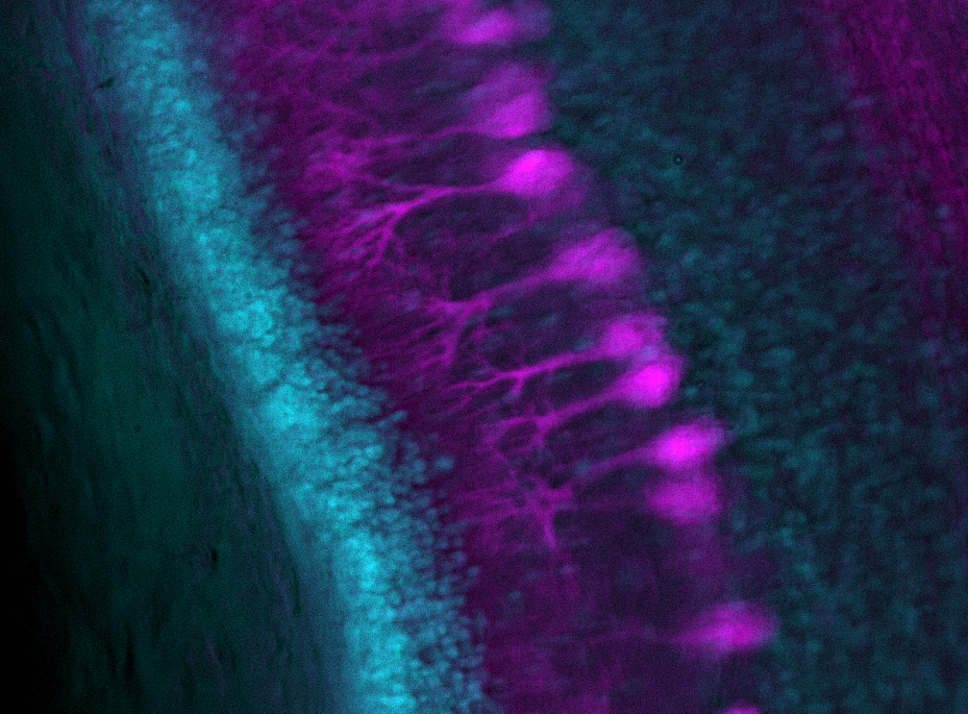Expanding the Dynamic Range of Light Microscopy-Based Analysis of Physiological and Aberrant Neural Circuit Development (EXPAND)
AdaBD made easy
How can we look at tiny things, such as nerve connections?
In this project, we establish laboratory techniques and microscopy approaches to be able to visualize neural networks and connections between neurons in different model systems. For example, we are using a special protocol to expand tissues up to 20 times. We are applying these techniques to investigate the effects on neural circuit formation of gene variants causing neurodevelopmental disorders such as autism.

Research project
The project EXPAND combines Expansion Microscopy (ExM), a method that expands biological samples up to 20 times, with other super-resolution microscopy approaches to investigate chemical synapses and neural circuits at the nanometer scale. Moreover, we image neural circuits in large samples with increased resolution by combining ExM with mesoscale selective plane illumination microscopy (mesoSPIM). This allows us to bridge the gap between the subsynaptic and the neural circuit level and to elucidate how gene variants causing neurodevelopmental disorders affect neural circuit architecture across spatial scales.
So far, we have investigated several genes (CADPS, FoxP1, FoxP2, and FoxP4) associated with neurodevelopmental disorders. Our results contribute to a better understanding of the roles of these de novo variants in neural disorders. For instance, our experiments revealed that loss of function of a synaptic gene (CADPS) enhances neuronal excitability, which may relate to the epilepsy phenotype of the patients. We also revealed specific defects in axon guidance in the peripheral nervous system after knocking down FoxP1, FoxP2, and FoxP4. The identified phenotypes after loss of FoxP1, FoxP2, and FoxP4 are in line with a potential contribution to the sensory perception differences seen in ASD patients
We have established several ExM protocols and integrated them with super-resolution light microscopy techniques, across different experimental systems, including the Drosophila neuromuscular junction (NMJ), chicken cerebellum, and human iPSC-derived neuronal cultures. Furthermore, we have begun combining ExM with stimulated emission depletion (STED) super-resolution microscopy to investigate the homeostatic modulation of synaptic nano-architecture in human iPSC-derived neurons and Drosophila synapses. Thus, this project provides the URPP with a versatile toolbox and an experimental pipeline that allows the systematic examination of neural circuits at increased resolution, and the characterization of candidate disease genes identified in patients.
Research groups
Principal investigators: Martin Müller, Esther Stoeckli, Anita Rauch
PhD students: Nasrin Bollmohr, Marta Brasili, Hanna Yeliseyeva
Collaborators: Gonzalo Saiz-Castro, Gabriele Siegel, Severino Thomasin, Lisa Kistler
Platforms: mesoSPIM
Publications
O’Neill Philipp S., Baccino-Calace Martín, Rupprecht Peter, Friedrich Rainer W., Müller Martin, Delvendahl Igor (2024)
A deep learning framework for automated and generalized synaptic event analysis.
eLife
Nair AG*, Bollmohr N*, Schökle L, Keim J, Melero JMM, Müller M (2024)
Presynaptic quantal size enhancement counteracts post-tetanic release depression.
J Physiol
Muttathukunnel P, Frei P, Perry S, Dickman D, Müller M (2022) Rapid homeostatic modulation of transsynaptic nanocolumn rings.
PNAS
Underlined: Current and previous AdaBD researchers
*: Equal contribution
